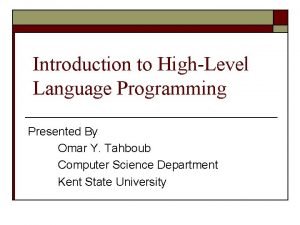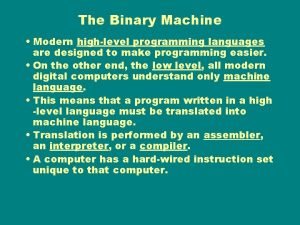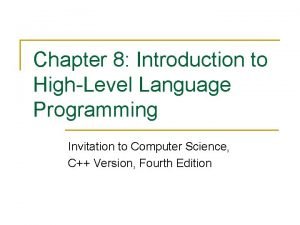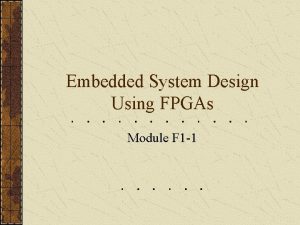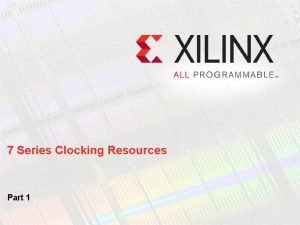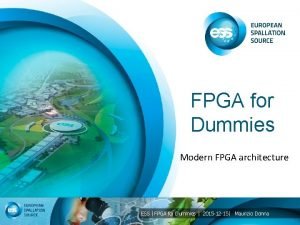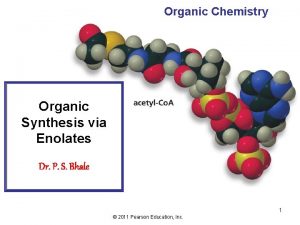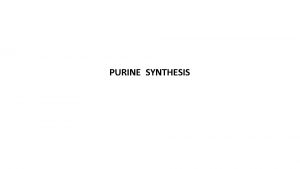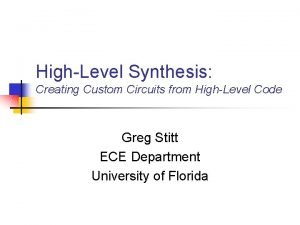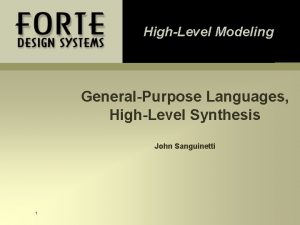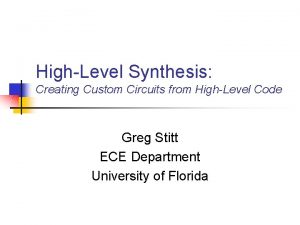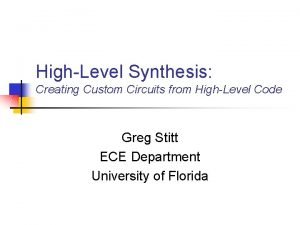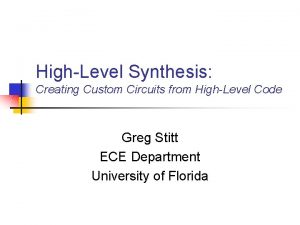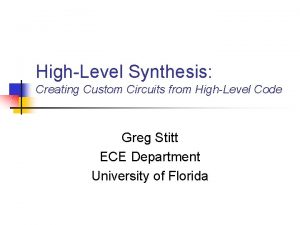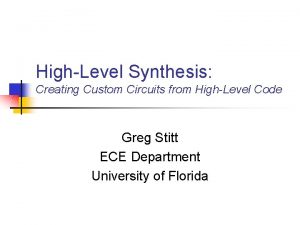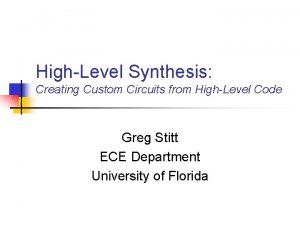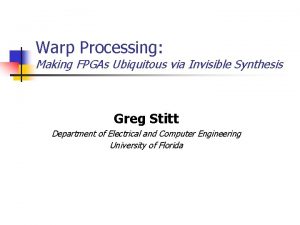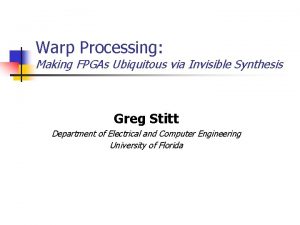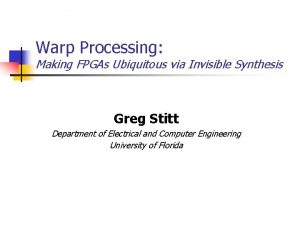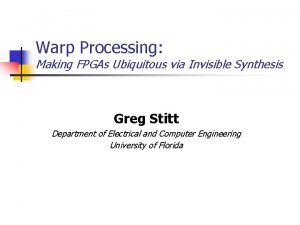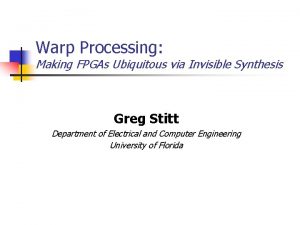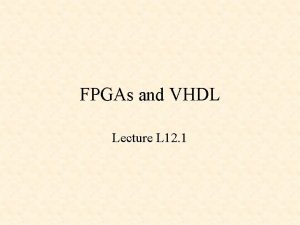LowEnergy HighPerformance Computing via HighLevel Synthesis on FPGAs
















- Slides: 16

Low-Energy High-Performance Computing via High-Level Synthesis on FPGAs Luciano Lavagno

Objectives and approach § Provide HW efficiency with SW-like nonrecurrent engineering cost – Exploit recent advances of High-Level Synthesis to enable a compilation flow for HW – Reduce HW design time (in particular verification time) by using High-Level Synthesis from a variety of concurrent models – Improve Quality of Results by means of manual and automated Design Space Exploration – Reduce energy consumption while retaining reprogrammability, by implementing SW on FPGA Electronics Group 2

Multi-language synthesis § No single winner in the domain of specification languages for HLS (synthesizing a high-level model into RTL) § C, C++, System. C, Simulink/Stateflow, CUDA/Open. Cl have all been proposed, and have all been successful to some extent § Avoid the need to learn a new language § Speed up development by enabling verification using a domain-specific language § C++/System. C can act as a common “intermediate language” between domain-specific modeling and HLS Electronics Group 3

HLS from Simulink models § Simulink/Stateflow is an industry-standard model-based design tool for: – Algorithmic modeling and simulation – Code generation for both SW and HW § HW implementation generation is limited to: – One or a few architectures (cost/performance points) – One or a few platforms (Xilinx- or Altera-specific tools) § Our approach: exploit well-established SW code generation in C – Customize code-generation for efficient HW implementation – Perform automated Design Space Exploration, without designer input – In case of broadly used blocks (e. g. FFT), write HLS-specific models for HW DSE Electronics Group 4

Model-based design from Simulink Fin Mo e Tun del e. S im ulin k Modeling, Simulation , Verification Model Translation (ERT Coder ) Wrapping ‘C’ model into System. C Embedded C Code Generation Wrapper Classes System. C Wrapping High Level Synthesis for HW Code Profiling and Partitioning Decisions Code for Embedded Processor

Automated Design Space Exploration Test. Bench Partition & Wrap RTL-1 RTL-2 RTL-3 RTL-n Logic Synthesis Gate-1 Gate-2 Gate-3 Gate-4 Switching Activity Database Gate Level Power Estimation Database (Excel Spread Sheet) Area Reports (Lib-cell) Power Reports Throughput Estimates

Automated DSE results

HLS from Open. Cl to FPGAs § A significant portion of the cost of data centers is due to energy consumption (both energy and cooling costs) § A large number of data center algorithms (e. g. search, image recognition, speech recognition) are “embarrassingly parallel” – Efficient code written in parallel languages is available § FPGA implementation provides a nice alternative to fullyprogrammable implementation on CPUs or GP-GPUs – Low-energy – Reconfiguration enables use for different applications – Good performance

ECOSCALE project goals § Scalability: 100 million computing units, billions of tasks Improve performance 1000 X wrt state of the art Sharing of acceleration and storage resources without global cache coherence � High energy efficiency: max 0. 5 W/unit Improve energy efficiency by 100 X FPGA use for high-performance computing � Reliability: 1000 hour MTBF Improve reliability by 1000 X Dynamic FPGA reconfiguration Electronics Group 9

Efficiency and programmability § HW implementation on FPGA: very high energy efficiency, while keeping dynamic reconfigurability § Open. Cl programming: extreme parallelism with simple programming model § Dynamic resource allocation: runtime FPGA reconfiguration § Efficient memory access: shared global memory among all CPUs and FPGAs in a cluster, without global cache coherency 10

Open. Cl programming model § Every kernel (functional computation unit mapped to CPU, GPU or FPGA) is divided into: – Completely independent workgroups, which can be assigned at runtime to different computation resources for best resource/performance trade-off – Cooperating synchronized workitems, which share local memory (SRAM) § The memory hierarchy explicitly distinguishes between: – Global DRAM (shared among kernels and with host code) – SRAM (shared among workitems) – Private registers § The programmer has already solved the most difficult problems: parallelization and efficient exploitation of the memory hierarchy 11

FPGA implementation § Both Xilinx and Altera support Open. Cl as a functional specification language – Workgroups can be replicated arbitrarily, to improve performance at the cost of resource usage – Workitems are pipelined for efficient HW implementation – Loops within a workitem and local memory must be implemented afficiently: automated Design Space Exploration § Xilinx SDAccel allows one to use “almost out of the box” Open. Cl code, integrating functional debugging and cost/performance analysis – Design Space Exploration must be automated, since it requires HW design expertis 12

Application examples § Financial algorithms: e. g. Black-Scholes and Heston – Monte-Carlo parallel simulations: no local or global memory – FPGA is much more efficient than GPU, in terms of both performance and energy-per-computation § Machine learning: e. g. K-nearest-neighbors – Limited by global memory bandwidth (GPU is typically better) – FPGA consumes much less energy, and can exploit streaming communication § Sorting: e. g. bitonic sorting – Limited by global memory bandwidth (GPU is typically better) – FPGA consumes much less energy, and can exploit streaming communication 13

Example: Heston model of financial markets platform t(ns) power(W) energy/step( n. J) GTX 960 0. 604 120 72 K 4200 0. 663 105 70 Virtex 7 1. 424 12 17 § No global memory use ensures competitive performance 14

Example: K-nearest-neighbors Platform Time GTX 960 930 ms 120 111. 6 3110 ms 108 335. 88 1 ms 3 0. 0039 K 4200 Virtex 7 Power(W) Energy(J) § On-chip global memory ensures very high performance 15 via streaming

Summary § Open. Cl and FPGAs provide an almost-ideal platform for highly-parallel software for data centers § Excellent energy-per-computation savings, with good performance § Some FPGA-specific high-level optimization is required – E. g. to exploit global memory access bursts § Several examples from different application domains provide encouraging results – Design space exploration is much easier than with other (less embarrassingly parallel) models – Dynamic resource management is key to data center and highperformance computing applicability 16
 Highlevel language
Highlevel language Highlevel programming language
Highlevel programming language Highlevel language
Highlevel language Highlevel language
Highlevel language Embedded microprocessor system design using fpgas
Embedded microprocessor system design using fpgas 7 series fpgas clocking resources user guide
7 series fpgas clocking resources user guide Fpgas for dummies
Fpgas for dummies Acetoacetic ester synthesis mechanism
Acetoacetic ester synthesis mechanism Marcha hicopoda
Marcha hicopoda Decimoquinta estacion del via crucis
Decimoquinta estacion del via crucis Via erudita e via popular
Via erudita e via popular La via negativa
La via negativa Cuantas estaciones tiene el via lucis
Cuantas estaciones tiene el via lucis Collaborating via social networks and groupware
Collaborating via social networks and groupware Conventional computing and intelligent computing
Conventional computing and intelligent computing Amp synthesis
Amp synthesis Protein synthesis
Protein synthesis
